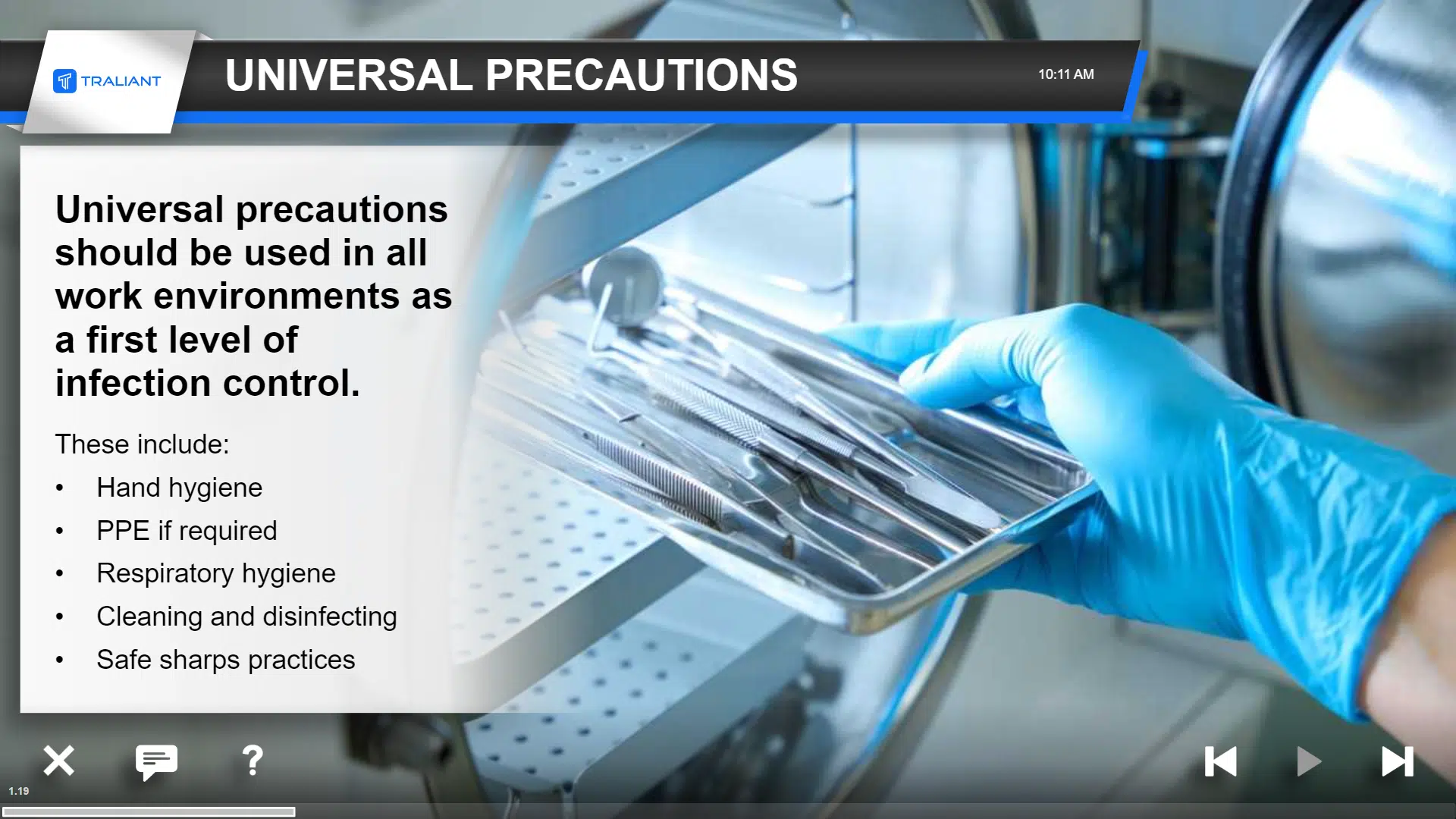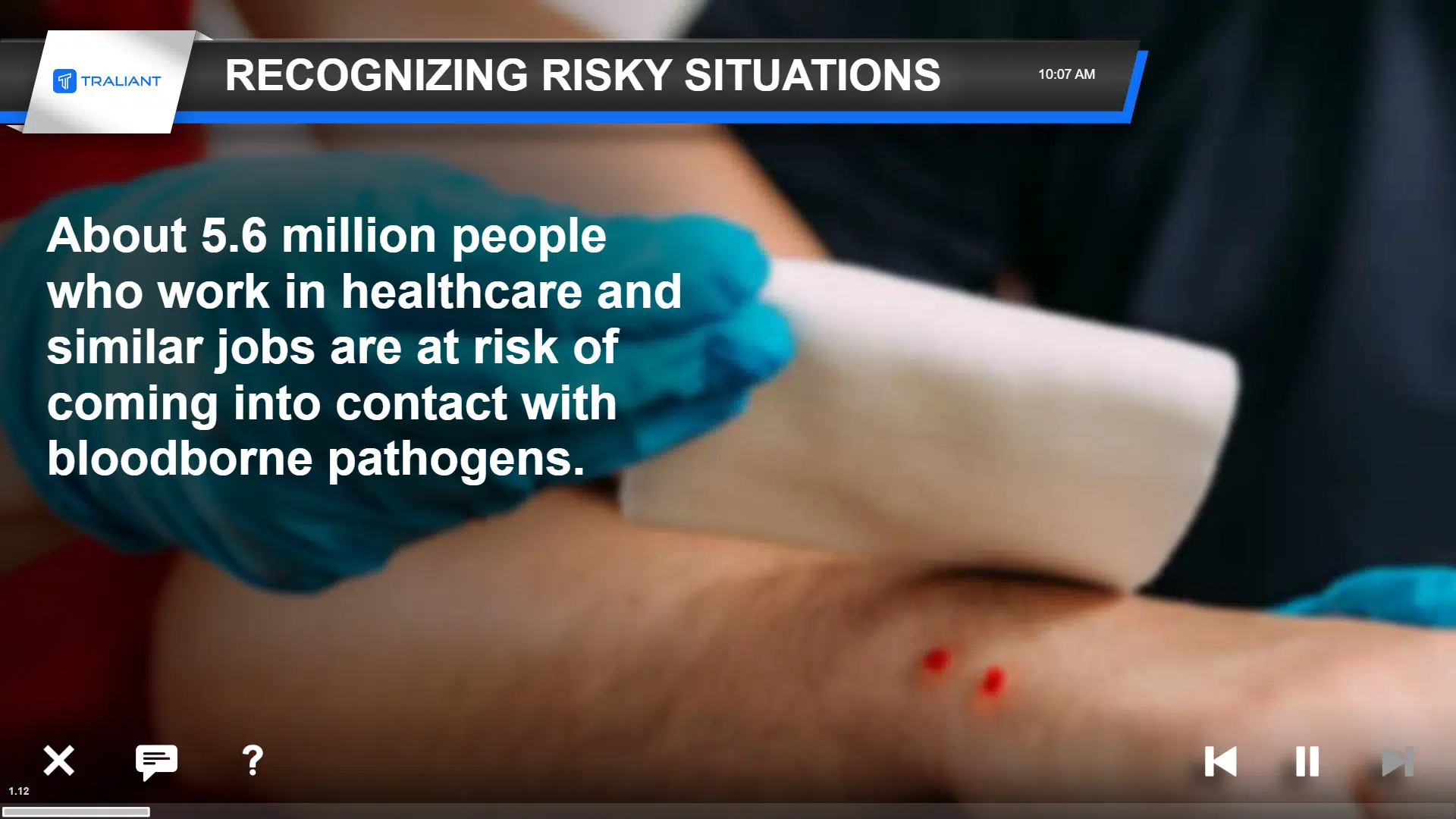
Bloodborne Pathogens
Give your employees the knowledge and skills to prevent infections and ensure a secure and safe work environment.
Course description
Traliant’s Bloodborne Pathogens is a 60-minute course designed to educate participants on the risks associated with bloodborne pathogens and provide essential knowledge and skills to prevent their transmission. This comprehensive course is designed to meet OSHA's Bloodborne Pathogens Standard (29 CFR 1910.1030) requirements.
ONLINE TRAINING
Bloodborne Pathogens

The course covers these topics and more:
- What are Bloodborne Pathogens
- OSHA Bloodborne Pathogen Standard
- Infection Control Measures
- Exposure Incident Response and reporting
- How to prevent exposures
- Examples of precautions
- Responding to an exposure incident
THE TRALIANT DIFFERENCE
Compliance you can trust.
Training you will love.

Legal expertise
Our in-house legal team monitors the latest laws, rules and regulations, so you don't have to. You can rest assured that our courses are continuously compliant.

Brilliant training
Take your training from boring to brilliant. With cinematic-quality videos produced by our Hollywood-based team, your employees will love our customizable, interactive, story-based training.

Valued partnership
Our main focus? It’s all about making your job easier. We do that with unmatched responsiveness and seamless deployment, dedicated to driving your success.

Meaningful impact
We don’t just deliver brilliant training, we help you create meaningful impact by broadening your employees' perspectives, achieving compliance and elevating culture.
KEY FEATURES
Why you'll love our training
It’s time to embrace a new era of online training with a valued partner who will ensure seamless implementation to fit your exact, a truly enjoyable learning experience and courses with continuous compliance you can trust.
Compliance expertise
Traliant's in-hour legal expertise ensures training is accurate and kept up-to-date with any regulatory changes.
Accessible to users with disabilities
Traliant provides an inclusive experience for all users, including those with disabilities, by going beyond Section 508-C standards and offering WCAG 2.1 AA.
Story-based learning
Our story-based approach blends leading instructional design with Hollywood talent to produce engaging, interactive and nuanced training.
Course administration
Traliant makes it simple to roll out training to your workplace and provide technical support directly to your employees at no additional cost.
Course customizations
Tailor courses to include your logo, relevant policies, workplace images, and more. Traliant can even customize the course with scenarios that take place in your own workplace environment.
Translations
Training is available in English, Spanish and is supported in over 100 languages.
COMPLIANCE EXPERTISE
Your partner in training compliance

Uniquely qualified in-house compliance team
Our exceptional in-house Compliance Advisory Team is led by Michael Johnson, Chief Strategy Officer and former U.S. Department of Justice attorney who has provided training and guidance to organizations like the Equal Employment Opportunity Commission, Google, the United Nations, and the World Bank.

Keeping you compliant, effortlessly
Keeping up with the complex web of employment laws — especially if your workforce spans multiple states — can be tricky. That’s why we offer a streamlined training solution that ensures you stay compliant with federal, state, and local regulations, so you can focus on what matters most: your team.

Simplifying your policies and handbooks
Crafting an employee handbook that meets legal standards can be daunting. Let us ease the burden. We help you navigate regulatory changes to ensure your policies and handbooks not only comply with the law but also reflect industry best practices.
What to consider when choosing the most effective Bloodborne Pathogens training

- Protect employee health: Bloodborne pathogens, such as HIV, Hepatitis B, and Hepatitis C, can cause serious illnesses. Training helps to ensure that employees understand the risks and know how to prevent exposure.
- Comply with OSHA regulations: The Occupational Safety and Health Administration (OSHA) has a Bloodborne Pathogens Standard that requires employers to provide training to employees who may be occupationally exposed to blood or other potentially infectious materials (OPIM).
- Reduce the risk of workplace transmission: Training helps to prevent the spread of bloodborne pathogens in the workplace by teaching employees how to safely handle potentially infectious materials.
- Empower employees: Training provides employees with the knowledge and skills they need to understand the risks, to protect themselves, and to respond appropriately in the event of an exposure incident.
- Strengthen your organization's commitment to safety: Training demonstrates the company's commitment to providing a safe and healthy work environment and to complying with OSHA's Bloodborne Pathogens Standard.
- Reduce the risk of OSHA violations and penalties: Training helps to ensure that organizations are complying with the standard and to minimize the risk of fines and penalties.
- Human immunodeficiency virus (HIV)
- Hepatitis B virus (HBV)
- Hepatitis C virus (HCV)
- Develop an exposure control plan: This plan outlines the steps that the employer will take to protect employees from exposure.
- Provide training: Employees must receive training on bloodborne pathogens, including the risks, how to prevent exposure, and what to do in the event of an exposure incident.
- Provide personal protective equipment (PPE): Employers must provide employees with appropriate PPE, such as gloves, gowns, masks, and eye protection.
- Offer Hepatitis B vaccinations: Employers must offer the Hepatitis B vaccine to employees who may be exposed to blood or OPIM.
- Implement engineering and work practice controls: These controls are designed to minimize the risk of exposure, such as using sharps containers and needleless systems.
- Establish procedures for handling exposure incidents: Employers must have procedures in place for reporting and managing exposure incidents.
- Use personal protective equipment (PPE): Always wear appropriate PPE, such as gloves, gowns, masks, and eye protection, when there is a risk of exposure to blood or OPIM.
- Practice good hand hygiene: Wash your hands frequently with soap and water or use an alcohol-based hand sanitizer.
- Use sharps containers: Dispose of needles and other sharps in puncture-resistant containers.
- Clean up spills properly: Clean up blood or OPIM spills immediately using an appropriate disinfectant.
- Wash the exposed area with soap and water.
- Report the exposure to their supervisor.
- Seek medical attention.
- Follow the organization's post-exposure procedures.






